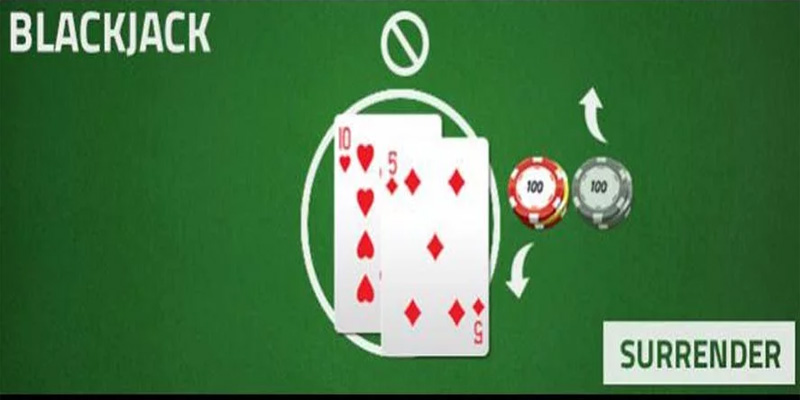Surrender in Blackjack is a unique and often misunderstood option that players can utilize during their game. It allows players to forfeit their hand before the dealer reveals their cards, potentially saving them from bigger losses. Understanding how and when to surrender can be crucial for a player’s overall strategy and success at the blackjack table.
Introduction to Blackjack and Surrender Option
Blackjack is a card game played between one or more players and a dealer, where the objective is to have a hand value as close to 21 as possible without exceeding it. The game combines elements of chance and skill, with players needing to make calculated decisions based on their hands and the dealer’s upcard. You can enjoy a thrilling game of Blackjack at 789bet, where strategy and luck come together for an exciting experience.
The “surrender” option adds another layer of complexity to this already strategic game. Players may find themselves in situations where they would rather cut their losses than continue playing a weak hand against a strong dealer’s card. Knowing when to utilize this tactic effectively could make a significant difference in your overall winnings.
What is Surrender in Blackjack?
Surrender in Blackjack is an option that allows players to give up their hand after the initial deal and recover half of their wager. When a player surrenders, they forfeit the other half of their bet but avoid the risk of losing their entire stake. This move is especially advantageous in scenarios where the odds are heavily stacked against the player.
There are two main types of surrender in Blackjack: early and late surrender. Early surrender allows players to take their loss before the dealer checks for blackjack, whereas late surrender occurs after the dealer has checked and revealed no blackjack. Each type has its own benefits, which should be considered depending on the specific circumstances of the game.
The Importance of Understanding Surrender in Blackjack
Understanding the rules and nuances of surrender can provide players with a strategic advantage. Many novice players overlook this option, believing that every hand should be played out regardless of the potential outcomes. However, savvy players know that sometimes it’s better to minimize losses rather than risk further bets.
Familiarizing yourself with when to surrender can lead to improved bankroll management and increase your chances of coming out ahead in the long run. Incorporating this strategy into your gameplay can also enhance your decision-making skills and help you become a more well-rounded player.
How Surrender Affects Your Overall Strategy
Incorporating the surrender option into your overall Blackjack strategy involves evaluating multiple factors. Beyond simply knowing when to surrender, you must also understand how this decision fits within your broader approach to the game, including card counting, bankroll management, and understanding dealer tendencies.
Using surrender wisely can allow you to prolong your playtime by preserving your bankroll, enabling you to take on more favorable betting opportunities in the future. As such, not only is surrender a tactical choice; it can also be a vital part of psychological warfare at the table, providing a buffer against frustration and chasing losses.
The Basics of Surrender in Blackjack
Before implementing any strategy involving surrender, it is essential to grasp the fundamental mechanics behind this option in Blackjack.
How Surrender Works in Blackjack
When you choose to surrender, you simply notify the dealer of your decision by stating “surrender” or placing your cards face down in front of you while pushing your betting chips away. This action signals that you are forfeiting half of your bet. The remaining half is returned to you, allowing for some financial recovery instead of a total loss.
The timing of your surrender is critical. Players only have the option to surrender right after the initial deal, meaning no additional cards can be drawn. It’s a decisive moment, and making the right call here can dictate your overall experience at the table.
Types of Surrender: Early vs. Late
As mentioned earlier, there are two types of surrender: early and late.
Early surrender allows you to abandon your hand before the dealer checks for blackjack. This means that if the dealer has an Ace or a ten-value card showing, you can still opt for surrender without worrying about the dealer having a natural blackjack. This option is significantly advantageous, as it decreases your exposure to higher losses.
On the other hand, late surrender comes into play after the dealer checks for blackjack. If the dealer does not have a natural blackjack, you can choose to surrender and retrieve half your bet. While late surrender is typically less optimal than early surrender, it can still be beneficial in certain situations.
The Pros and Cons of Using Surrender
While surrendering can save players from excessive losses, it also has its downsides.
The primary advantage of surrender is loss mitigation. By opting to forfeit, players reduce their risk in unfavorable scenarios, preserving their bankroll for better opportunities. Moreover, understanding surrender can elevate a player’s gameplay, as it signifies a deeper awareness of strategy.
However, the downside is that surrendering means giving up the opportunity to win the round entirely. Some players may also feel emotionally conflicted about surrendering, feeling they’ve been defeated by bad luck or misfortune. This psychological aspect can influence their gameplay and decision-making in future rounds.
Conclusion
Surrender in Blackjack is a valuable tool for players looking to manage risks effectively and optimize their gameplay. By understanding what surrender entails, recognizing the best situations to use it, and combining it with other strategies, you can improve your decision-making and ultimately enhance your enjoyment of the game.


